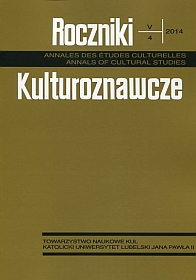Where Is the Holy Land?
Abstrakt
Gdzie jest Ziemia Święta?
Ziemia Święta, czyli obszar uważany za Terra Sancta przez żydów, chrześcijan i muzułmanów, jest bardzo dobrze znany, ale jej granice nie są dokładnie ustalone, ponieważ każdy we właściwy dla siebie sposób definiuje ten szczególny obszar. Mapa Ziemi Świętej jest mentalnym tworem istniejącym w wyobraźni, utworzonym w zależności od przekonań osób zajmujących się tym zagadnieniem. Szczególną cechą Ziemi Świętej jest, z jednej strony, uznanie jej za świętą przez trzy religie, z drugiej zaś fakt, że mamy do czynienia nie tylko z listą świętych miejsc, co jest czymś powszechnym na całym świecie, ale ze świętym obszarem, w którym te święte miejsca się znajdują. Tradycja żydowska wskazuje trzy różne granice, chrześcijańska granica natomiast nie jest dokładnie określona, muzułmańska zaś opinia jest prawie nieznana. Aktualne granice Izraela i Palestyny nie są granicami Ziemi Świętej, jakkolwiek pielgrzymi udający się na ten święty teren odwiedzają te współczesne państwa z przekonaniem, że jest to Ziemia Święta.
Bibliografia
Baker, Alan R.H., John D. Hamshere, and John Langton (eds.). Geographical Interpretation of Historical Sources. London: Barnes and Noble, 1975.
Biger, Gideon. The Boundaries of Modern Palestine, 1840-1947. London: Routledge, 2004.
Casey, Edward S. The Fate of Place: A Philosophical History. Berkeley: University of California Press, 1997.
Clarke, Katherine. Between Geography and History: Hellenistic Constructions of the Roman World. Oxford: Oxford University Press, 1999.
Davies, William D. The Gospel and the Land: Early Christianity and Jewish Territorial Doctrine. Berkeley: California University Press, 1974.
Haggett, Peter. Geography: A Modern Synthesis. London: Heinemann, 1975.
Halbwachs, Maurice. The Collective Memory, trans. from the French by Francis J. Ditter Jr. and Vida Yazdi. New York: Harper & Row, 1980.
Kitchin, Rob, and Mark Blades. The Cognition of Geographic Space. London: I. B. Tauris & Co Ltd., 2002.
Kong, Lily. “Geography and Religion: Trends and Prospects.” Progress in Human Geography, 14 (3) (1990): 355-371.
Kong, Lily. “Religious Geography.” In: James Duncan and Nuala C. Johnson (eds.). A Companion to cultural geography. Oxford: Blackwell Publishing, 2004.
Le Strange, Guy. Palestine under the Moslems: A Description of Syria and Holy Land from 650 A.D. to 1500 A.D. New York, NY: Cosimo Classics, 2010. First published in 1890.
Portugali, Juval. The Construction of Cognitive Maps. Dordrecht: Kluwer Academic Publishing, 1996.
Shweid, Eliezer. The Land of Israel. National Homeland of Land of Destiny. London and Toronto: Farleigh Dickson University Press, 1985.
Sopher, David E. Geography of Religion. Englewood Cliffs, NJ: Prentice-Hall, 1967.
Tuan, Yi-Fu. Topophilia: A Study of Environmental-Perception Attitudes and Values. Englewood Cliffs, NJ: Prentice-Hall, 1974.
Walker, Peter I. Christian Attitudes to Jerusalem and the Holy Places in the Fourth Century. Oxford: Oxford University Press, 1990.





